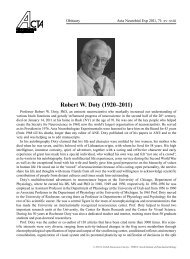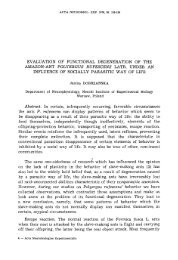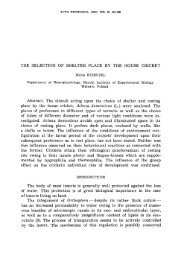Auditory perception of temporal order in centenarians in comparison ...
Auditory perception of temporal order in centenarians in comparison ...
Auditory perception of temporal order in centenarians in comparison ...
You also want an ePaper? Increase the reach of your titles
YUMPU automatically turns print PDFs into web optimized ePapers that Google loves.
378 I. Kolodziejczyk and E. Szelag<br />
(Divenyi and Hirsh 1974). When us<strong>in</strong>g the global strategy,<br />
there is no need to identify the separate stimuli,<br />
but to recognize a modulated pattern left-to-right or<br />
right-to-left (Szymaszek et al. 2006).<br />
It is known that strategy adaptivity (i.e. the ability to<br />
choose the most appropriate strategy for the task)<br />
decl<strong>in</strong>es with age (Lemaire et al. 2004). Thus, younger<br />
subjects were probably more prone to modify the<br />
advised strategy <strong>in</strong>to a more global one which improved<br />
their performance, whereas old people relied more on<br />
the advised analytical strategy.<br />
The lack <strong>of</strong> significant differences between the<br />
young and the elderly subjects confirms the results<br />
reported by other authors, who found only a small deterioration<br />
<strong>of</strong> TOJ <strong>in</strong> subjects aged between 20 and 70<br />
years for monaurally presented clicks, but a significant<br />
deterioration for tones <strong>of</strong> different pitch presented either<br />
monaurally or b<strong>in</strong>aurally (Fitzgibbons and Gordon-<br />
Salant 1998, Gordon-Salant and Fitzgibbons 1999, F<strong>in</strong>k<br />
et al. 2005, Szymaszek et al. 2006). Our results are <strong>in</strong><br />
agreement with these observations and confirm that<br />
TOT for monaurally presented sounds rema<strong>in</strong>s relatively<br />
stable up to the age <strong>of</strong> about 70. However, a huge<br />
decl<strong>in</strong>e is observed <strong>in</strong> very old people.<br />
The distribution <strong>of</strong> D-n-K responses suggests that<br />
age-related <strong>in</strong>crease <strong>of</strong> TOT could be <strong>in</strong> part related to<br />
the avoidance <strong>of</strong> guess<strong>in</strong>g displayed by the oldest subjects.<br />
This pattern <strong>of</strong> performance <strong>in</strong> very old people<br />
was reported <strong>in</strong> paper-and-pencil tests, where old people<br />
were more prone to answer D-n-K than younger<br />
ones (Schwarz and Knäuper 1999). S<strong>in</strong>ce <strong>in</strong> our study<br />
D-n-K was classified as an error, it could contribute to<br />
the level <strong>of</strong> performance. However, <strong>in</strong> 16 subjects who<br />
never used D-n-K (i.e., 6 young, 8 elderly and 2 <strong>centenarians</strong>),<br />
similar age-related deterioration <strong>in</strong> TOTs was<br />
still observed (mean TOTs 26, 60, and 124 ms for 20-,<br />
65- and 100-year-olds, respectively). This observation<br />
supports our <strong>in</strong>terpretation <strong>of</strong> age-related changes <strong>in</strong><br />
<strong>in</strong>formation process<strong>in</strong>g speed, <strong>in</strong>ternal clock rate or<br />
strategy adaptivity (see above). However, these <strong>in</strong>fluences<br />
could have been modified by the age-related differences<br />
<strong>in</strong> avoidance <strong>of</strong> guess<strong>in</strong>g.<br />
Another question is whether the relatively low<br />
scores on the MMSE <strong>in</strong> some <strong>centenarians</strong> could <strong>in</strong>fluence<br />
their TOTs. As mentioned above <strong>in</strong> the Subject<br />
Section, the score on the MMSE was not an <strong>in</strong>clusion<br />
criterion, because normative data for such an old population<br />
is lack<strong>in</strong>g. It should be noted that <strong>centenarians</strong><br />
with low scores on the MMSE <strong>in</strong>cluded <strong>in</strong> the study<br />
showed a relatively high level <strong>of</strong> mental function<strong>in</strong>g,<br />
good contact with the researcher dur<strong>in</strong>g the test<strong>in</strong>g as<br />
well as a lack <strong>of</strong> serious neurological problems (see<br />
above). Us<strong>in</strong>g the value <strong>of</strong> 23 <strong>in</strong> MMSE as a cut-<strong>of</strong>f<br />
score for <strong>centenarians</strong> with lower (n=6) vs. higher<br />
(n=5) mental status, we obta<strong>in</strong>ed TOTs <strong>of</strong> 230 vs. 132<br />
ms, respectively. Look<strong>in</strong>g at Fig. 1, we conclude that<br />
although the low score on MMSE accompanied elevated<br />
TOTs, the pronounced deterioration <strong>of</strong> the TOTs<br />
was still observed <strong>in</strong> <strong>centenarians</strong>, <strong>in</strong>dependently <strong>of</strong><br />
their mental status.<br />
Another factor that could contribute to the agerelated<br />
decl<strong>in</strong>e <strong>in</strong> TOTs may be education. As seen <strong>in</strong><br />
Table I, <strong>centenarians</strong> had significantly less formal education<br />
than people <strong>in</strong> the two younger groups. Because<br />
<strong>of</strong> important transformations <strong>in</strong> the educational system<br />
across generations, it would be impossible to balance<br />
our age groups with respect to the amount <strong>of</strong> education.<br />
Although any evidence on the direct <strong>in</strong>fluence <strong>of</strong><br />
education on TOT is lack<strong>in</strong>g, some authors suggested<br />
its relation to cognitive function<strong>in</strong>g <strong>in</strong> old people<br />
(Letenneur et al. 1999, Le Carret et al. 2003). It may be<br />
reflected <strong>in</strong> results <strong>of</strong> our study, where 2 <strong>centenarians</strong><br />
with the highest education (13–15 years) and 5 <strong>centenarians</strong><br />
with the lowest education (3 years) showed<br />
mean TOTs <strong>of</strong> 140 vs. 221 ms, respectively. Therefore,<br />
we argue that although low education accompanies the<br />
elevated TOTs <strong>in</strong> <strong>centenarians</strong>, serious deterioration<br />
could be observed <strong>in</strong> this group, <strong>in</strong>dependently <strong>of</strong> education.<br />
To summarize, although both education and<br />
mental status could <strong>in</strong>fluence the performance <strong>of</strong> the<br />
very old subjects, the decl<strong>in</strong>e <strong>in</strong> TIP was still evidenced<br />
<strong>in</strong> this group.<br />
Age-related differences <strong>in</strong> the <strong>perception</strong> <strong>of</strong> <strong>temporal</strong><br />
<strong>order</strong> were also <strong>in</strong>fluenced by subjects’ gender with<br />
better performance, <strong>in</strong> general, <strong>in</strong> men than <strong>in</strong> women.<br />
This difference was significant only <strong>in</strong> <strong>centenarians</strong><br />
(Fig. 1). Referr<strong>in</strong>g to the exist<strong>in</strong>g studies, the data concern<strong>in</strong>g<br />
the gender effect on the <strong>perception</strong> <strong>of</strong> <strong>temporal</strong><br />
<strong>order</strong> are few and <strong>in</strong>consistent. For example, Kanabus<br />
and colleagues (2002) reported the lack <strong>of</strong> a gender<br />
effect <strong>in</strong> young subjects, whereas Wittmann and Szelag<br />
(2003) as well as Szymaszek and others (2006) proved<br />
better performance <strong>in</strong> men than <strong>in</strong> women <strong>in</strong> the age<br />
range from 20 to 70 years. In another paper the gender<br />
effect was not clear <strong>in</strong> subjects aged 20–70 years (F<strong>in</strong>k<br />
et al. 2005). Thus, on the basis <strong>of</strong> these studies it is<br />
difficult to make any clear conclusion on the gender<br />
effect on TOJ <strong>in</strong> people aged 20–70 years.









